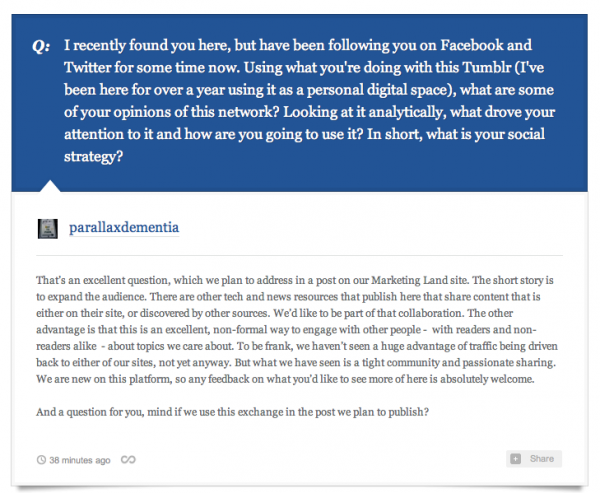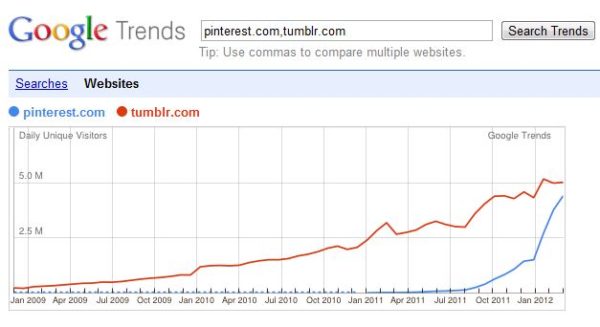Why We Are On Tumblr
We recently launched our Marketing Land and Search Engine Land accounts on Tumblr. We’ve been quietly developing them this month, familiarizing ourselves with the platform in terms of how to post, what to post, who to follow and ultimately defining why we should be there in the first place. If you’ve been thinking the same, perhaps […]

Why Tumblr?
Here’s a response to launching our accounts after we announced them on Facebook:
If we attract 12 year-olds to the world of search or internet marketing, that’s not a bad thing. But no, that’s not why.
So what is our social strategy in the move, as someone asked us today on Tumblr itself:
Our response:
That’s an excellent question, which we plan to address in a post on our Marketing Land site. The short story is to expand the audience. There are other tech and news resources that publish here that share content that is either on their site, or discovered by other sources. We’d like to be part of that collaboration.
The other advantage is that this is an excellent, non-formal way to engage with other people – with readers and non-readers alike – about topics we care about.
To be frank, we haven’t seen a huge advantage of traffic being driven back to either of our sites, not yet anyway. But what we have seen is a tight community and passionate sharing. We are new on this platform, so any feedback on what you’d like to see more of here is absolutely welcome.
Brands Should Be Where The People Are
In other words, as responsible tech news brands, we really should be on there. The same goes for Pinterest. In fact, according to Alexa, the reach between Tumblr and Pinterest is about the same:
Don’t trust Alexa rankings? Sure, they can be dubious. But Google Trends also shows the same:
Getting To Know Tumblr
When we decided to claim the Marketing Land brand, we initially had a hard time. Someone had squatted the name, but because the blog wasn’t being used, Tumblr quickly responded and released it for us.
The platform itself is not difficult, but getting a full grasp of how to post, how to provide attribution to other posters, how to attract the power users (editors) in different sectors and how to track our activity from the site took a bit more time.
Being Seen
The biggest opportunity for visibility is really the dashboard stream that appears when you are logged in, which aggregates the Tumblr blogs you follow. Here’s an example of how this one post was featured as a top tech item, simple because we attracted the right audience to highlight it as newsworthy:
Tumblr allows tagging of posts; making sure you select relevant tags seems key to helping your content spread.
I Can Haz Logo?
Like any other platform, there’s a lot of testing to be had. One feature we discovered that is only available to some hand-picked sites is to have posts branded with logos. For example, here is a Wall Street Journal Story shared by Danny Sullivan:
You’ll notice the Wall Street Journal has a branded post. Of course, they are the Wall Street Journal. Other big brand news sites have it as well, such as CNET and The New York Times. But most sites don’t.
According to Tumblr, this treatment is only available “some of our most popular sources,” likely because they manage it manually and don’t have the infrastructure to support it for everyone. But, perhaps they could make it possible for a site to provide its own source image through a meta tag. Put a Tumblr tag on the site you represent, and have it call that?
With Twitter’s recent acquisition of Posterous, Tumblr’s biggest competitor, and the list of media organizations actively working on there now, Tumblr is not a platform we can easily dismiss, nor likely can anyone. We’re already managing a little differently than Google+ and Facebook, so if you have ideas on what you’d like to see more of on Tumblr, definitely pass them along.
Opinions expressed in this article are those of the guest author and not necessarily MarTech. Staff authors are listed here.
Related stories





